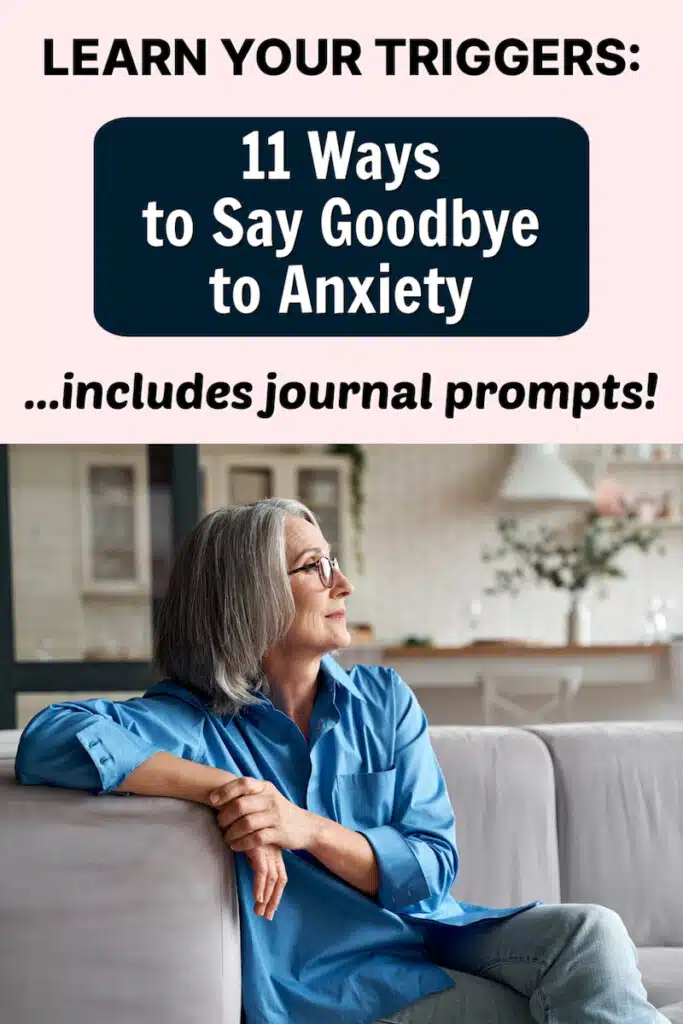Do you believe yourself to be more anxious, on average, than other people?
Anxiety is a normal human emotion. It’s a natural response to the world around you and your feelings about the daily challenges you face.
However, anxiety can impact your overall health negatively when it becomes overwhelming or lasts too long.
If you’re experiencing anxiety more often than you’d like, the tips below will help you replace anxiety with serenity.
The Difference Between Anxiety and Serenity
Anxiety and serenity are two opposite emotional states with distinct features:
- Anxiety is a feeling of uneasiness, worry, or fear often accompanied by physical sensations such as increased heart rate, discomfort, sweating, or muscle tension. It can be triggered by various factors – such as stress, uncertainty (ruminating about the future), and impending danger.
- Conversely, serenity is a state of calmness, tranquility, and peacefulness. It’s characterized by contentment and relaxation.
How to Replace Anxiety with Serenity
Anxiety and serenity are necessary human emotions that serve different and important purposes.
Anxiety helps you stay alert and avoid potential threats.
Serenity, on the other hand, helps you relax and recharge your energy.
When anxiety becomes chronic, it interferes with daily functioning and can lead to mental health problems such as increased feelings of panic, overwhelm, exhaustion, or fear.
In contrast, serenity enhances your overall well-being and your ability to cope with stress.
Therefore, it’s not a matter of which emotional state is better, but rather a balance between the two:
- A certain level of anxiety can be helpful in certain situations, but excessive anxiety can be harmful.

- Similarly, a certain level of serenity benefits your mental and physical health – but too much can lead to complacency and a lack of motivation.
Finding the right balance between anxiety and serenity is key to achieving optimal mental and emotional health.
Included below are important details about where anxiety comes from, the symptoms it presents, and how you can release anxiety from your mind and body – so you can feel centered and whole again.
1. Deep Breathing Techniques Lessen Anxiety
The innate intelligence of the human body already knows how to metabolize anxiety.
An extended exhale allows for more carbon dioxide to be expelled, which in turn signals the body to relax and reduces your feelings of angst.
“Physiological sighs, or double inhales followed by an extended exhale, are the way that we reset the respiratory system and rid ourselves of that feeling of anxiety… It’s a very powerful way to bring the level of autonomic arousal back down, and it’s something that can be done anywhere, anytime.”
–Andrew Huberman, neuroscientist
Take a deep breath in and out through your nose. Make your exhalations longer than your inhalations. Repeat this process until you feel yourself finding the stillness of your center.
You can close the gap between anxious feelings (fear and worry) and the feeling of serenity (ease, freedom, abundance, and fulfillment).
You can accomplish that in five minutes of nose breathing and positive thoughts (more on this in the next step).
In a sense, it’s only a vibrational gap that you have to close, and then better feelings will manifest.
2. Use Journal Prompts
Another step in dealing with anxiety is to identify the triggers that are causing it.
Anxiety is a feeling of worry or apprehension that can range in intensity from mild to severe.
When faced with a potentially threatening situation, the body’s natural fight or flight response is triggered.
- Some common physical symptoms of anxiety include rapid heartbeat, sweating, trembling or shaking, shortness of breath, and nausea.
- Psychological symptoms of anxiety may include excessive worry, restlessness, irritability, difficulty concentrating, and restless sleep.
Anxiety can come from many different sources, and you may not realize what those sources are until you start looking closely at your life.
One way to get good at identifying those beliefs and thoughts that may be sponsoring anxiety is to keep a daily journal in which you write down your feelings.
Journal prompts are prompts or questions that can guide your writing and help you explore your emotions in a deeper way.
A journal prompt can be anything that inspires you to write from your inner-most self.
The goal of journal prompts is to encourage you to explore your thoughts and feelings in a safe and non-judgmental way.
Prompts can help you identify patterns in your thinking or behavior, gain insight into your emotions, and develop greater self-awareness.
Using journal prompts regularly can be a helpful tool in managing your mental health and improving your overall well-being.
Journaling is a personal practice, so it’s important to choose prompts that resonate with you and feel meaningful.

Journaling helps you to better pinpoint what was happening in your life up until the point where your anxiety began:
- What were you doing?
- Who was around?
- How did they act?
- What conclusions were you reaching, either consciously or unconsciously?
You may not be able to pinpoint exactly why something caused an increase in one type of anxiety over another, but being able to recognize patterns will help guide future treatment plans so that they can be put into action sooner rather than later.
Journaling can be an effective way to work through your feelings and process your emotions. If you’re anxious, journaling can help you get things off your chest, so they don’t build up inside.
Other journal prompts include:
- I’m building a “happy place” in my mind as vividly as possible. Here’s what it looks like, sounds like, smells like, and feels like… (Tip: start with a location – are you at the beach? In the mountains? etc.)
- What about my life is working well right now?
- When I fantasize positively about my future, I like to imagine…
- One of my favorite parts of my typical day is…
Writing about your day and identifying feelings of gratitude can be therapeutic, calming, and can be cathartic.
You can also use it as a way to track progress — if you start writing down how often you experience anxiety before and after taking certain actions (e.g., taking a walk), then this will shine light on what helps alleviate it or make it worse.
TIP: when writing in your journal, try to also identify positive beliefs, thoughts, and feelings that you might be having.
As humans, we tend to get more of what we focus upon.
Including your positive experiences within your journal can help keep your outlook bright.
In particular, include those things for which you feel grateful.
3. Avoid “Provoking Stimuli” When Possible
If there are specific situations that seem potentially like anxiety-provoking stimuli (“major triggers”), then try avoiding them when possible.
For example, if getting into unnecessary disagreements makes you anxious, then maybe don’t have conversations with people who tend towards being argumentative.
4. Try Talk Therapy. It Works.
If you’re feeling anxious, counseling can help. In fact, it’s one of the most effective ways to tackle anxiety. With a therapist or counselor, you can explore why you feel anxious and learn how to manage your emotions.
Counselors will likely ask questions about what triggers your anxiety and why it occurs in certain situations. They’ll also help lead the conversation toward possible solutions for managing it better — whether that means making lifestyle changes or learning more effective ways of dealing with stress.
Counseling can help identify the patterns that might be causing your anxiety in the first place.
5. Sleeping Deeply
A good night’s sleep is essential.
If you’re not sleeping enough or well enough, it can affect your mood and leave you feeling stressed and anxious. Aim for 7-9 hours a night, particularly if you have difficulty falling asleep or staying asleep. Keep in mind that some people may need more sleep than others.
If you’re a light sleeper, you may want to consider blackout curtains, a white noise machine, an eye mask, a small dose of melatonin (ask your doctor), or earplugs. Also, it might be wise to ease up on the caffeine.
6. Anaerobic Exercise
Exercise releases endorphins that make you feel good about yourself. Fitness training reduces stress levels because it helps you deal with everyday problems more efficiently by giving you a sense of control over your life.
If possible, try to make time for some kind of physical activity every day — even if it’s just taking a brisk walk around the block or going for a light jog through your neighborhood before dinner. You’ll feel better both physically and mentally after doing so.
The best thing about working out for managing anxiety is that it doesn’t cost anything. It isn’t mandatory to buy expensive products or programs. Just get outside and get moving.

TIP: if you want a real mood booster, do sprint drills or higher-intensity intervals. This type of exercise releases extra brain chemicals that usually help you feel zestful and accomplished afterward.
7. Eat Healthier Foods
Nutrient deficiencies contribute to anxiety.
“It’s estimated that over 90% of Americans are deficient in at least one essential nutrient, and that 50% of the population is deficient in at least one vitamin.”
–Peter Attia, M.D.
Eating healthy foods can help combat feelings of stress by providing an abundance of nutrients to your body – nutrients that are essential for good health.
Avoid those modern inflammatory foods – such as processed items, fried or sugary snacks, and pizza – that tend to create brain fog, bloating, and lethargy.
A diet rich in vegetables can help ensure good health while providing sufficient nutrients to keep anxiety at bay.
8. Resist the Temptation to Self-Medicate with Alcohol
Drinking alcohol will only make it harder for you to deal with anxiety symptoms because alcohol impairs judgment and clouds rational thinking processes — which is exactly what you’re trying to avoid. At best, alcohol doesn’t remove anxiety; it just postpones it.
9. Avoid Overthinking
Worrying about things that are out of your control – or worrying about what other people think about you – can be a significant cause of anxiety.
Try to be aware of whether or not you’re getting caught up in a cycle of negative thoughts.
Remind yourself out loud that “the past is done, and the future hasn’t happened yet.”
We have all had bad days or have been through difficult times, but it isn’t necessary to let those experiences get looped in your head and stop you from enjoying life in the moment.
The future may not seem like an option right now — but just imagine what lovely things might happen if you remained decidedly positive and focused on your desires and goals.
Do not worry about things that are out of your control. Think about it this way: if you’re worried about something, and it turns out fine – you wasted time worrying. Instead, try thinking positively.
10. Instead of Being a Rushed Person, Be a Centered Person
Don’t get into the habit of rushing through different tasks or being too impatient with yourself.
Rushing creates stress, which leads to feeling anxiety.
Take your time with your tasks, and worry less about how much time remains until a particular event.
Leaving the house late – and then getting frustrated in traffic and driving fast to make your next appointment – is an untidy, frantic way to live. It’s the opposite of chillness.
11. Recognize Anxiety as an Opportunity
Anxiety is a real thing, but it’s also a condition that can be treated.
To grow mentally and spiritually as a person, you’ll want to be able to face changes and challenges with strength and grace.
I’ve found a natural, nerdy way to manage anxiety: organizing. It has worked really well for me. I think because I do it with a sense of humor. Have a look at this video.
The intention is – with time – to get better at metabolizing anxiety.
That means you develop an internal process that gets more adept at turning anxious thoughts into positive outcomes.
Anyone can learn how to do this. It just takes patience and a genuine, deliberate wish to get better at it.
Anxiety Sometimes Happens After Age 50
In particular, daily life after the age of 50 presents unique challenges that perhaps younger people encounter less often.
Mature people often feel some degree of stress about:
- retirement savings,
- how their offspring are fairing,
- loss of personal strength, stamina, and mobility,
- ailing friends,
- gradual lessening of sight, hearing, and mental acuity,
- balancing work, errands, chores, and free time,
- and mortality.
Anxiety sometimes mirrors – or happens in conjunction with – other mental challenges. Here’s what you need to know:
Anxiety VS Panic Attack
Anxiety and panic attacks are two related but distinct experiences.
Anxiety is a persistent feeling of worry, fear, or apprehension about future events or uncertain outcomes. It can cause physical symptoms, such as muscle tension, sweating, and rapid heartbeat. Anxiety can range from mild to severe, and it can be related to specific situations or be more generalized.
A panic attack, on the other hand, is a sudden and intense episode of fear or terror that can come on without warning.
Panic Attack Symptoms
Panic attacks are often accompanied by physical symptoms such as rapid heartbeat, sweating, trembling, chest pain, shortness of breath, and a feeling of impending doom or loss of control.
People who experience panic attacks often report feeling like they’re having a heart attack or are about to die.
While anxiety can be a chronic or ongoing experience, panic attacks tend to be shorter in duration and more intense.
Panic attacks can occur in response to a specific trigger, such as a phobia or traumatic event, or they can occur seemingly out of the blue (panic attacks can be a symptom of panic disorder, which is a type of anxiety disorder).
Anxiety VS Depression
Depression is a mood disorder that is characterized by a persistent feeling of sadness or loss of interest in activities that were once enjoyed.
Other common symptoms of depression include difficulty concentrating and feelings of hopelessness.
While anxiety can cause feelings of apprehension, depression tends to be characterized by a lack of pleasure in life.
People with depression may also experience physical symptoms, such as fatigue and changes in appetite or sleep patterns.
Conclusion on Replacing Anxiety with Serenity
If you’re experiencing symptoms of anxiety or depression that interfere with your daily life, it’s important to seek assistance from a mental health professional.
Take comfort in knowing there are solutions. By being action-oriented and addressing your anxiety directly, you can – in time – experience more daily joy in your life.
Research has established that changing habitually negative thoughts and learning to relax your body consciously can be very helpful.
A review of meta-analyses in Cognitive Therapy (2013) and another study by Boyraz and Lightsey (2012) found that positive automatic thoughts, which involve changing negative thinking patterns, can moderate the relationship between stress and well-being.
Other treatment options include therapy, medication – or a combination of both – depending on the individual’s needs and the severity of their symptoms.
With proper treatment and support, many people experiencing these challenges can effectively manage – or alleviate – their symptoms and significantly improve their quality of life, experiencing more satisfaction, meaning, and laughter.
Additional Resources on Reducing Anxiety After 50:
Nutrient Deficiencies and Mental Health – https://www.ncbi.nlm.nih.gov/pmc/articles/PMC2738337/
Gut Bacteria and Anxiety – https://chriskresser.com/your-gut-microbiome-and-anxiety-whats-the-connection/
Research on Thought Replacement – https://www.ncbi.nlm.nih.gov/pmc/articles/PMC4760272/
